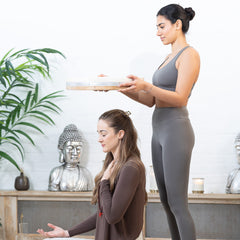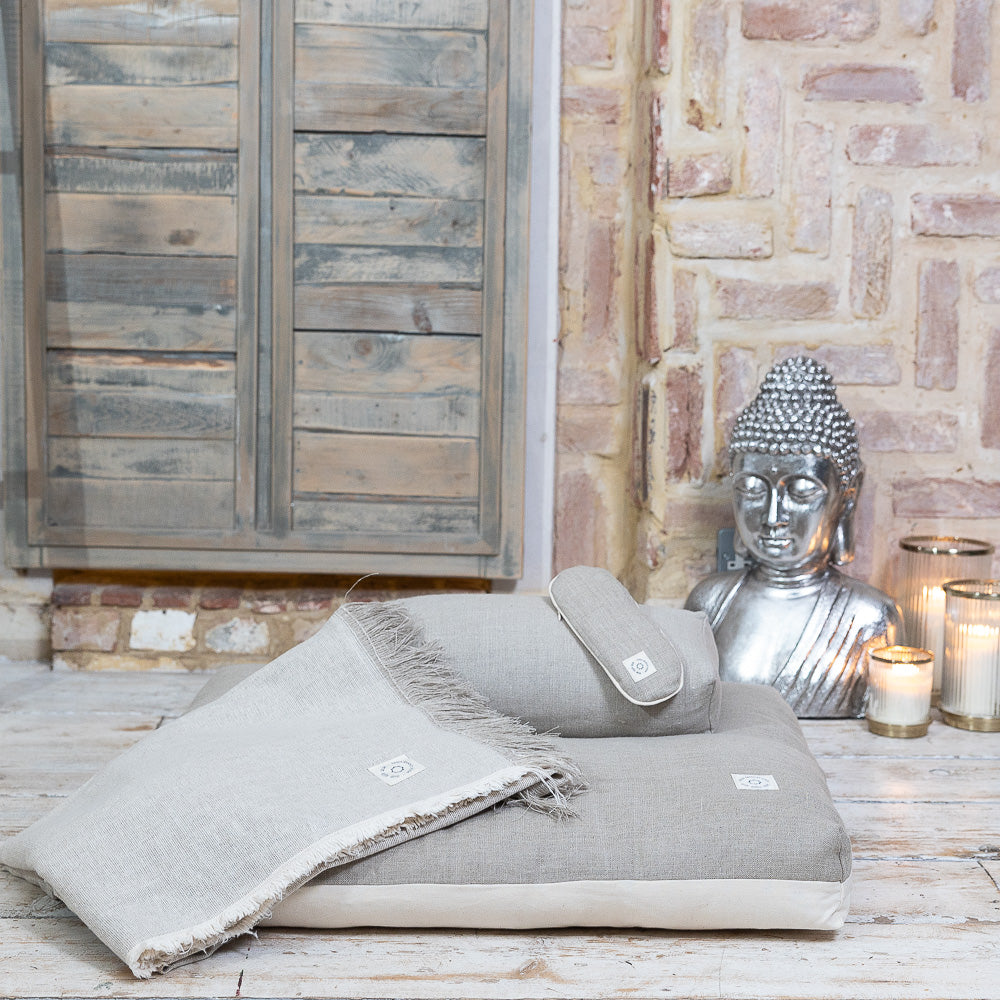Whether you're new to the practice of meditation or a seasoned meditator with years of experience, a meditation space that offers a personal sense of calm, intention, and focus is essential. While meditation spaces do not need to be permanent, having a location you can turn to in your home to relax and centre yourself is key.
In this post, we'll guide you through how to create this dedicated space to fit your needs, work around limitations, and help lift your practice.
What is a meditation space?
A meditation space is an area specifically set up for meditating. It will look different from person to person, suited to what they need for a peaceful and focused practice. For some, it may be a corner of a well-used room in the home, dressed with temporary decorations that can be neatly tidied away after each session. For others, it may be an entire room dedicated to meditation, fitted with permanent features that only change when the user wishes.
It doesn't matter what your meditation space looks like, as long as it suits the purpose of elevating your personal practice.
Why is a dedicated meditation space important?
There are several factors that can contribute towards a positive experience when meditating. These include low sound levels, as few disturbances as possible, and a space that feels safe. When these, and other elements, are aligned, you'll find your meditation flows smoothly, leaving you feeling the benefits in a far more impactful way. This is why it's highly encouraged to have a space that allows for focus.
How to set up a meditation space
While the space can be designed to your exact preferences, there are certain elements that most people find essential when creating their meditation zone. Below are loose guidelines and suggestions, not strict rules, to help you build a space that works for you. We understand that, depending on location and home size, not all of these will be possible to follow, so do your best with what you have in a way that leaves you feeling positive with the results.
1. Choose your location
Picking the perfect spot is one of the most important decisions in your meditation space creation.
Quiet
First, find an area of your home where the sound levels are low - if possible, the quietest spot in your home. This is to minimise noisy distractions, allowing you to sink fully into your practice without jumping every time the loo flushes or getting distracted by the TV playing. If possible, avoid spaces by windows that face busy streets and rooms with loud household appliances. Try scattering cushions, soft textiles, and other items that absorb sound to catch those wayward audible distractions.
Natural light
Next, we encourage you to choose a space with plenty of natural light. Here in the UK, different directions receive different sunlight levels depending on the time of day. If your window faces east, you'll get direct sunlight in the morning. South-facing windows get sunlight for most of the day, making it the most desirable direction. Windows facing west get direct sunlight in the late afternoon and early evening, while north-facing windows see the least amount of sun. If possible, choose a space with a window facing the direction that works best for you - for example, if you like to meditate in the morning, an east-facing window would be ideal.
If natural light isn't accessible, don't worry - artificial light does a good job of replicating it. Choose candles and warm-toned bulbs with, if possible, dimming functions, and you'll be able to create the vibe of a softly lit space.
Distraction-free
Finally, choose a space that won't deliver constant interruptions in the form of family, pets, and other distractions. Find a space that isn't high-traffic, a zone that family members won't need to walk in and out of while getting on with their own day. Of course, you cannot prevent a toddler from strolling in on a whim, so consider talking to your family about not interrupting you while you meditate. Find a fun and quiet activity for them to enjoy while you meditate, or invite them to practice with you!
Whatever size works for you
Before you worry about not having enough space, let us assuage your concerns: ample space is not a requirement to meditate. As long as you have room for something to comfortably sit on and space to stand up and manoeuvre, we promise your practice will go just fine.
2. Clear the space
The well-known adage 'tidy house, tidy mind' can be applied to your meditation space with ease. If you want a distraction-free and focused session, ensure the space you choose is clear of clutter. The only items in the space should be those you have chosen to elevate your practice, or those that cannot be removed, such as those present if your space is only temporary. If the latter is the case, consider having a dedicated bit of storage that you can put items into while you practice, which can then be unpacked again after.
If possible, ensure there are no screens to tempt you away from your practice. From laptops to mobile phones, we can be very easily distracted by gadgets, so keep them out of your space to avoid temptation.
3. Get comfortable
Comfort is key in meditation; if you're sitting on a hard surface or bent in a strange position to avoid furniture, we would advise you to readjust your space.
Comfortable seating
Cosy seating is essential. Meditation pillows, Zafus, and, if you're fortunate enough to have the space, meditation beds, are all wonderful tools to help you feel physically comfortable. This will allow you to focus on your practice, rather than on how your lower back is starting to ache. We highly recommend looking into which type of seating is right for you and which piece will help you reach your desired meditative results. Our meditation seating is all designed to provide the perfect place for you to perch or rest during meditation, crafted with soft yet supportive materials to enhance your experience.
Temperature
What is the temperature like in your chosen space? You'll want to find an area that's not too hot or too cold - extreme temperatures either way can be incredibly distracting, so aim for a space or room that feels just right to you. If your space meets all of our suggestions but is in a cool area of the home, consider a meditation blanket to keep you cosy.
4. Add your meditation necessities
Adding meditation tools to your space isn't essential, but they can help to improve your practice if you find them useful or beneficial. Yoga and meditation accessories such as crystal singing bowls, cymbals, and other sound healing equipment can really lift your experience with their vibrations, helping relieve stress and promote deep relaxation. Aromatherapy can be wonderful too - essential oils and incense can further calm your mind and reduce stress with their fragrance. Try calming lavender incense for relaxation, and stimulating rosemary essential oil for focus.
5. Decorate mindfully
This is where you can truly let your creativity loose. Decorate your space in a way that speaks to you, while keeping it mindful to allow for as few distractions as possible. Choose items with intention, pieces that have meaning behind them, and work on creating a visual balance that helps you relax and centre yourself.
If you're unsure of what will work for you, don't be afraid to experiment until you find the right visual fit. Here are some ideas you can try:
-
Fresh flowers and plants
-
Natural wood pieces and seashells
-
Crystals and mandalas
-
Candles and salt lamps
-
Nature-themed photography and prints
-
Rugs and textile wall hangings
Some often ask the question: What colour should a meditation room be? You should choose whichever colour makes you feel most at peace. Typically, these colours are soothing shades such as soft blues, gentle greens, and other neutrals, as they replicate those found in nature. It's recommended to avoid bold colours like vibrant reds and bright purples, as these can evoke feelings of anxiety or overstimulate you.
6. Evolve and adjust
Your first finished result does not need to be permanent. As people, we change, and so do our practices. Evolve your space alongside you, and adjust it when you feel it is time to add something new or remove something that no longer has meaning.
Sometimes, it can be nice to change things around even when they're working, just for a fresh perspective. This sort of transition can be awakening, and revitalise what you may not have realised was starting to fall flat.
Create your own personal meditation space
If you're ready to build a special meditation space in your home, let us help. We have a range of wonderful products, each designed to truly elevate your practice, along with a wealth of rich content to advise you, including our guide to breathing for enhanced well-being.
Take a look through our carefully curated collections and find the pieces that speak to you and your meditation practice.


